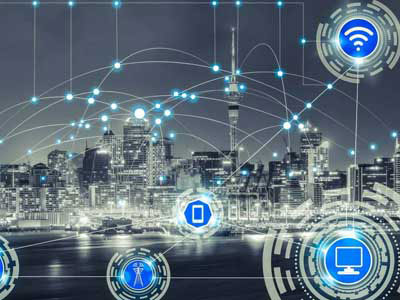How Is Big Data Used In IoT?
Key Takeaway
Big data is integral to the Internet of Things (IoT), enabling businesses to analyze vast amounts of data collected by IoT devices in real-time. This data can be used for predictive analytics, allowing organizations to anticipate device failures or maintenance needs before issues arise.
Big data also enhances compliance and regulatory processes by ensuring data protection and adherence to privacy laws. It aids in access control by analyzing user behavior for precise authorization settings. Additionally, big data organizes information into useful datasets, optimizing operations like traffic management or home efficiency. In healthcare, IoT devices capture health metrics, enabling real-time monitoring and research advancements.
The Role of Big Data in Enhancing IoT Functionality
Big Data plays a crucial role in enhancing IoT functionality. IoT devices generate massive amounts of data, which, when properly analyzed, can reveal patterns and trends that were previously hidden. For instance, in smart homes, data from various sensors can be analyzed to automate routines and improve energy efficiency. In industrial settings, data from machinery can be used to predict maintenance needs, thereby preventing costly breakdowns. By leveraging Big Data analytics, IoT systems become more intelligent and responsive, leading to smarter and more efficient operations.

Analyzing IoT Data for Business Insights
Analyzing IoT data provides businesses with critical insights that drive strategic decisions. For instance, retail companies can leverage IoT data to understand customer behavior patterns, optimizing store layouts and personalizing marketing efforts. This data-driven approach enhances customer experiences and increases sales. In healthcare, data from wearable devices can be analyzed to track patient health trends, enabling proactive care and improving patient outcomes. The key is to transform raw data into actionable insights. This requires engineers and data scientists to collaborate closely, developing sophisticated algorithms and models. These tools must accurately interpret vast amounts of IoT data, providing meaningful business intelligence. By converting raw data into strategic insights, businesses can streamline operations, improve efficiency, and deliver superior customer experiences.
Effective data analysis hinges on the ability to process and interpret complex data sets. Retailers, for example, can use foot traffic data to identify peak shopping times and adjust staffing levels accordingly. In manufacturing, IoT data can reveal inefficiencies in production lines, leading to process improvements and cost savings. Engineers play a crucial role in designing systems that capture high-quality data and ensure its integrity. Data scientists, on the other hand, focus on extracting insights through advanced analytics and machine learning techniques. This synergy between engineering and data science is essential for maximizing the value derived from IoT data, ultimately driving business growth and innovation.
Big Data Techniques in IoT Data Processing
Several Big Data techniques are crucial for effective IoT data processing. Real-time analytics allows businesses to respond instantly to data, providing immediate insights and facilitating quick decision-making. Machine learning algorithms identify patterns and anomalies, improving predictive maintenance and fault detection in industrial settings. Predictive analytics uses historical data to forecast future events, aiding in better planning and preparation.
These techniques together enable businesses to fully utilize IoT data, driving innovation and efficiency. Engineers and data scientists must work together to implement these tools, ensuring they meet the organization’s specific needs and maximize data value.
Case Studies: Successful Big Data Applications in IoT
There are numerous successful applications of Big Data in IoT across various industries. For example, in agriculture, IoT sensors combined with Big Data analytics have enabled precision farming. Data on soil moisture, weather conditions, and crop health is analyzed to optimize irrigation and fertilization. This has led to increased yields and reduced resource consumption.
In the automotive industry, IoT data from connected cars is analyzed to enhance vehicle performance and develop autonomous driving technologies. Data on driving patterns, engine performance, and environmental conditions is used to improve safety features and fuel efficiency.
These case studies demonstrate how integrating Big Data and IoT drives innovation and efficiency, leading to significant improvements in performance and cost savings. For engineers, understanding these applications provides valuable insights into how to leverage Big Data for IoT solutions effectively
Challenges in Managing Big Data in IoT
Managing Big Data in IoT presents several challenges. The sheer volume of data generated by IoT devices can overwhelm traditional data processing systems, necessitating scalable solutions. Ensuring data privacy and security is a major concern, as IoT devices often collect sensitive information. Unauthorized access or breaches can have serious implications.
Integrating data from diverse sources and maintaining its quality and accuracy adds another layer of complexity. Different devices and formats require advanced data integration and cleansing techniques to ensure consistency and reliability.
To address these challenges, businesses must invest in robust data management infrastructures, implement stringent security measures, and employ sophisticated data integration methods. Overcoming these obstacles is essential for fully leveraging the potential of Big Data in IoT, ensuring operational efficiency and unlocking valuable insights.
Conclusion
To maximize the potential of IoT, businesses must effectively leverage Big Data. By utilizing advanced analytics, machine learning, and predictive techniques, companies can transform vast amounts of raw data into actionable insights. This not only enhances operational efficiency but also drives innovation and competitive advantage. Engineers and data scientists play a pivotal role in developing and implementing solutions that harness the power of Big Data in IoT. By addressing the challenges and embracing the opportunities, businesses can unlock the full potential of IoT, leading to smarter, more efficient, and more responsive operations.
